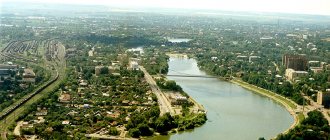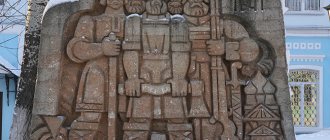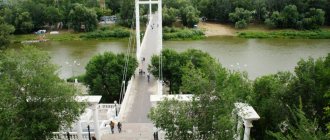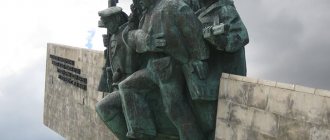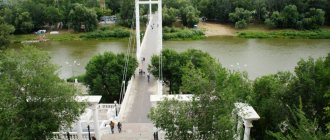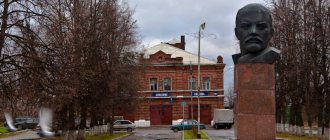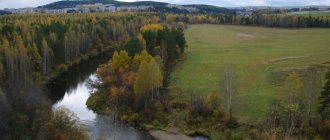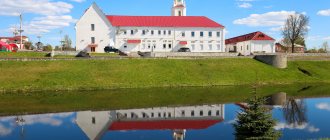Methodological development “Historical buildings of Orenburg”
Historical
building
V
Orenburg
Sovetskaya, 1
The second half of the 19th century was a period of stylization. At this time, the number of floors increased even in provincial Orenburg, although the buildings generally did not go beyond two floors. In the seventies, the first five-story building in the city appeared (Sovetskaya, 1). It was built for a military educational institution and is designed for living quarters and classrooms.
Sovetskaya, 32
House 32 on Sovetskaya Street, built in the mid-seventies of the 18th century, saw many outstanding people within its walls. This typical provincial mansion is also interesting because it, built during the period of classicism, deviates from the rules of the latter and instead of window openings and doors along the axis of symmetry of the main facade has piers. This house is from 1833-1841. It was filmed by military governor V.A. Perovsky, a very extraordinary person. V. I. Dal and many others, perhaps A. S. Pushkin, visited him here more than once on business and on business.
Elizabeth Gate
This low stone gate made of plastered brick is installed in front of the reconstructed historical descent to the Ural River. The gate is crowned with a bas-relief depicting the state emblem of the Russian Empire surrounded by military paraphernalia - banners, axes, guns and cannonballs. In the middle of the coat of arms are the initials of Empress Elizabeth and the date - 1755. In addition to these decorations, two angels are installed in the niches on both sides of the gate, holding a shield and a palm branch in their hands. This gate is a reconstruction of the ancient gate of the city rampart, called the Water or Elizabeth gate. The city received them as the highest gift from Empress Elizabeth Petrovna to the governor of the Orenburg region I.I. Neplyuev as a reward for suppressing the Bashkir rebellion. Initially, the gate was installed at the site of the modern intersection of Burzyantsev and Maxim Gorky streets, near the road from the city to Menovaya Dvor. Subsequently, it was postponed several times. In 2008, the Elizabeth Gate was restored on its historical foundation using surviving drawings and photographs. The bas-reliefs that decorated the gates were preserved, but for safety reasons they were replaced with exact copies.
Some old-timers said that these gates had magical powers - as soon as a guy took a photo under them with his beloved, victory awaited him - the girl would definitely become his wife.
Gostiny Dvor in Orenburg
Gostiny Dvor
- a characteristic monument of commercial origin
Gostiny Dvor
is located in the center of Orenburg - between Sovetskaya, Kirov, 9th January and Pushkinskaya streets. Currently there is a shopping complex here.
Gostiny Dvor
began to be built almost simultaneously with the city of Orenburg. Its length was 104 fathoms and its width was 94 fathoms. The main architect and builder was Johann Werner Müller.
It was a beautiful building for that time.
Gostiny Dvor
was a fortress: it was surrounded by a high stone wall. An ancient tower still rises above the western gate. Inside there were 150 shops and barns. Vaults and canopies over the shops made it possible to trade in any weather. Gradually, the Gostiny Dvor was remodeled so that the doors and windows of the shops began to open onto the street.
Gostiny Dvor
served as a place for winter trade. However, the busiest trade was in the summer, since in winter the Kazakhs went to the distant steppes for the winter.
In the corners of Gostiny Dvor
had four bastions. The remains, or rather the locations of these bastions, can still be seen today.
Museum of Orenburg History
The museum building was erected in 1856, designed by architect Skalochkin, style - late Gothic. The museum building looks very much like a medieval castle. The museum was opened for the 240th anniversary of the city of Orenburg in April 1983. The museum includes four branches: the Memorial Museum-Guardhouse of Taras Shevchenko, the Museum-Apartment of Yuri and Valentina Gagarin, the House of Memory, and the Memorial Museum-Apartment of the Rostropovich Family.
Oreburg Museum of Local Lore
The beautiful building of the regional museum of local lore (Orenburg, Sovetskaya street, 28) was built in 1831. The building was built in the style of late classicism. All its facades, except for the courtyard, are formal. The central portico of the Ionic order stands out, which is raised to the mezzanine level and rests on the arcade. The museum is located in the mansion of the merchant Yenikutsev, an architectural monument of the 19th century.
After the October Revolution, this building housed various party and Soviet institutions. Regional Museum of Local Lore
has been here since 1946.
The museum's funds contain the most valuable books on the history and economy of our region, exhibits of national importance: the banner and certificate of the All-Russian Central Executive Committee, awarded to Orenburg workers for the heroic defense of Orenburg in 1919. The plaster mask of the greatest Russian poet A.S. Pushkin (one of three in existence) is carefully kept here. It was removed from Pushkin’s face by the writer V.I. Dahl and brought to Orenburg. In the halls of the museum there is exhibited a cannon made by Ural workers for Pugachev, original decrees of Pugachev, wonderful paintings by the Itinerant artist Lukian Vasilyevich Popov and many other exhibits.
Among the collections of the nature department are samples of minerals discovered in the Orenburg region - ores, oil, various salts, ornamental stones and building materials. Photographs and diaramas, stuffed animals, various models and dummies - all this helps visitors get a clear idea of the Orenburg region in all its diversity. The collections of the local history museum are systematically replenished. Its workers annually conduct archaeological, archaeographic, ethnographic and other expeditions.
Guardhouse
This building is in Orenburg on the street. Soviet, was built in 1843.
For some reason, this building, standing above the steep cliff of the Urals, is called a “fortress” by many. Obviously, for the unique architecture and decorative tower, narrow windows, vaguely reminiscent of loopholes. But this is not a fortress. The building was originally intended to store the governor general's archives and securities, but was adapted for a guardhouse. For more than a hundred years, violators of military discipline of the Orenburg garrison served here the “term established by the commander.” Among the cadets of our military schools there was an unwritten law - if you leave the “lip” - sign on one of its stones! Until recently, one could read the names of its former “guests” on the bricks of the end wall. On April 27, 1851, the arrested poet and artist Taras Grigorievich Shevchenko was placed here.
Nowadays, the museum of the city of Orenburg is located here. But he did not get here right away - after lengthy negotiations with the military department.
Guardhouse
is interesting for its tower, not so much for the tower as for the history associated with the clock that was once installed on it. Their musical chime, every half hour, carries far away from the steep bank of the Urals, fading somewhere in the Asian distance.
Over time, it was rebuilt - and not in the best way: the building is not at all painted by the windows broken into the mezzanine floor on the front facades, the portico with a balcony, the belvedere on the roof and a number of other elements and details were lost.
House of Officers
Today it is difficult to imagine Sovetskaya Street without the original turret that crowns the corner bay window of the House of Officers. Before the revolution, this huge building, owned by the merchant Troshchin, was an entertainment center. There was a cinema "Olympus", a spacious restaurant, a confectionery and coffee shop "Cake", five billiard rooms and much more. The building is in Art Nouveau style.
Belovka
Builders of the Orenburg
They erected a redant on the high bank of the Urals - an open area without a rampart or ditch, protected from the enemy only by a coastal cliff.
In 1857, the redant was turned into a boulevard, the first trees were planted, and a pavilion for a buffet was built. Flowerbeds and fountains appeared. The local merchant Belov built a light building called the Station, where music was played in the evenings. Since then, the boulevard named after Ya.M. Sverdlov, called Belovka
.
In the sultry steppe a fortress was built, and a city was built. It was painful for its residents to endure the time when there was no escape from the heat and dust, when the sand crunched in their teeth... The military governor Count of Essen was the first to decide to enter into battle with nature - he demanded that all homeowners have a front garden in front of their house, and each resident was male , starting from the age of twelve, plant a certain number of trees and care for them. He monitored the execution of his orders very strictly. But it was difficult to grow trees - the city did not have enough water. Essen even thought about installing a water supply system...
Exhausted by the heat and dust, residents were drawn to the river, to the life-giving coolness, to the Trans-Ural Grove
.
But it was not landscaped. Essen orders engineer Major General Bikbulatov to lead the reconstruction of the Trans-Ural Grove - to lay alleys, replant trees, select and improve places for public beaches. Through his efforts, the Transural Grove
soon becomes the favorite vacation spot of the townspeople. And for many years, on weekends and holidays, the music of military bands sounded here, and visitors were entertained by specially selected soldier songwriters. Every summer, the European coast was connected to the Asian coast by a narrow pile bridge. A bathing area was built next to the bridge, and pleasure boats were also available here. From the wide alley leading to the Big Glade, a whole network of smaller ones was laid. And all of them were regularly sprinkled with sand by the soldiers. Along the Staritsa, which has survived to this day, there is an alley lined with trees that, according to legend, were planted during the reign of Essen. The steep, steep bank also underwent reconstruction - a steep descent-staircase was made along it to the Urals. A little to the left, straight from the Elizabethan Gate, there was a staircase, consisting of separate flights of six to eight steps and intermediate platforms between them for rest. The remains of this descent, heavily damaged and cluttered, remain to this day. During the Great Patriotic War, it was still among those active. Women and children, heavily laden with gifts from melon and potato plots, climbed up the mountain along it. Parallel to these stairs, a little to the right, there was a pedestrian path along which cyclists pulled their garden luggage up.
The embankment has also been reconstructed several times. Merchant Belov, an almost illiterate man, but exceptionally smart and enterprising, laid out flower beds; next to the old descent, at the Elizabeth Gate, he erected a gazebo pavilion where soft drinks were sold. He built a restaurant on stilts, right above the steep bank. And things worked out for him! Directly from the restaurant, he laid another gentle slope without steps, which snaked almost to the river.
Currently, in the center of the boulevard there is a monument to V.P. Chkalov, in the depths of the alley, on a concrete pedestal - a memorial cannon, a beautiful embankment, a pedestrian bridge over the river, cabins on the cable car. The center of the boulevard turns into a descent to the Ural River. A staircase with columns and gazebos leads to a pedestrian bridge connecting the city with the largest recreation area - the Transural Grove. Under the steep right bank of the Urals there is a miniature railway station, from which trains depart exactly on schedule. This is a children's railway: children have been traveling on it and serving it since 1953. The railway leads to the Dubki pioneer camp area.
Gazebo-rotunda in Leninsky Square
A typical building of landscape architecture in the style of classicism is the rotunda gazebo in Orenburg. Most likely, it was built in 1829 in the Trans-Ural Grove during the reign of military governor P.K. Essen, who had a passion for gardens and parks.
Paths were laid in the grove and wooden gazebos were built. On holidays, an orchestra played and fireworks were displayed.
The rotunda is a typical element of park buildings of the Classical era.
The gazebo was built, presumably, according to the design of the architect Alfeev. In the 1890s, the gazebo was moved to Aleksandrovsky Square (now V.I. Lenin Square). In the center of the gazebo there used to be a fountain with a figure of cupid, now lost.
Water tower
In 1904, an original building appeared at the intersection of Zhukov and Pobeda avenues. It was intended for water purification in the city and had a volume of more than 80 buckets. Although the volume is small, the very fact of the appearance of such a tower in the city and providing residents with drinking water was the first step towards industrialization and development of the economy of the city and region.
Today it is a historical monument of Orenburg and a landmark of the city. The picturesque tower building is located in a historical area; it used to be surrounded by one-story residential buildings; there was a stone mill behind the water tower until 1939.
Now next to the tower there are: the Orenburg Regional Philharmonic, a television center and, in architectural contrast, a library building. When the intersection and the tower building are illuminated at night, this part of the city becomes unusual and interesting for tourists.
Currently, the building houses various commercial structures.
Caravanserai
The Orenburg Caravanserai was built at the expense of ordinary people from 1837 to 1846, the author of the project is A. P. Bryullov.
It is a complex architectural work, which consists of a main building, a minaret and a mosque. Only at the beginning of construction it was located on the outskirts of the city; now it is the central part, surrounded by residential buildings. But the main work was completed in 1842 and another 4 years were spent on finishing external and internal work.
The date of the grand opening of the caravanserai is 1846.
Initially, it was assumed that the main building would be occupied by the apartments of the commander of the Bashkir army, as well as a hotel for Bashkirs coming to Orenburg on business. In addition, there were plans to establish a school here with various workshops for Bashkir children. In 1865, the Bashkirs put forward demands for the return of the Caravanserai, built at their expense and by themselves. But it was returned only in 1918. In 1921, the Bashkir Pedagogical College opened here; in 1924, the complex was given to the Orenburg province. Since 1960, it has been considered an architectural monument and is under state protection.
Train Station
As they say, “The theater begins with a coat rack, and the city begins with a station.” The station in Orenburg is one of the most beautiful in our area. It was made in the spirit of St. Petersburg architecture. It was opened on December 31, 1876.
Cable car
In 2006, a cable car was opened Orenburg , which makes it possible to travel from Europe to Asia . Its length is 233 meters. Passengers travel in cozy translucent cabins. This project even took the status of “The most comfortable cable car in Russia” . The speed of your movement through the air will be 3 m/s, so during the flight passengers have time to take pictures of the river, bridge and embankment from a height of 70 meters.
Shawl Museum
The down scarf began to be made in the Orenburg province around the 18th century. The museum displays historical exhibits telling about the emergence and development of this craft. You will experience delight and surprise, because this is a real miracle! A scarf created using ancient technologies can pass through a wedding ring! The secret of its softness and strength is the special fluff provided by local goats. The excursion will be interesting for tourists of any age.
Victory Park
In summer in Orenburg it is pleasant to walk around the city. It pleases with greenery and fountains. It can even be a pity to waste time on museums. In this case, I recommend visiting an open-air exhibition of military equipment. It is located in Victory Park . Here you can see tanks, planes, self-propelled guns and even trains. The exposition plays out in a very interesting way. You can climb in the trenches, climb onto a train or sit on a cart. Everywhere there are information signs telling about the exhibit.
Space Museum
The Museum of Cosmonautics is located in the flight school where famous pilots of the country trained: Yu. Gagarin , V. Lebedev , Yu. Lonchakov and others. For a long time, the largest exhibit of the museum stood in front of the building - the MiG-15 aircraft Yuri Gagarin flew in 1961 . The school recently celebrated its 95th anniversary. Over its history, it has trained 28 thousand pilots and navigators. Of these, there were 252 Heroes of the Soviet Union, 10 twice Heroes of the Soviet Union and 4 cosmonauts!
The pilots of this school were the first in history to master the skies over the Arctic and Antarctic . In 1963, the first cosmonaut school in the Soviet Union . And then the cosmonautics museum . Part of the collection included personal belongings of Yu. Gagarin and his flight log.
In 1993, the school was disbanded. Within these walls is located the cadet flight school, the first stage of training. The local residents gave the educational institution a funny name: among themselves they call it “letka.”
National village
The Urals is a region where more than 100 nationalities live. Each has its own traditions and values. You can learn about them in the National Village , where the farmsteads of the 10 most numerous peoples living in Orenburg and the region . Here you can get acquainted with Tatar, Bashkir, Kazakh, Russian, Georgian and other cultures. Through cuisine, literature, crafts and everyday life, you will notice the commonalities and differences between the represented peoples.
Elizabeth Gate
While walking along the embankment, go to the Elizabeth Gate . This is one of the symbols of the city! The history of their appearance is connected with the Bashkir uprisings in the Orenburg lands in 1755. Then the governor of Orenburg I.I. Neplyuev heroically suppressed the Bashkir uprising. In memory of this, Empress Elizabeth gives a gate , which she orders to be installed at the exit from the city, towards the steppes, so that all nomads remember the power of the Russian army . Over time, the gate collapsed. Their fragments can be viewed in the local history museum . And in 2008, a copy of them was installed on the embankment.
Toy railway
It just seems like the little train and fairytale stations are made for children. In Orenburg, the Children's Railway is the most adult attraction! The road was built not only for skiing, but also to transport parents to country health camps. The railway line runs along the Ural River . Very picturesque landscapes alternate with brightly decorated stations. I recommend everyone to take a ride, not just tourists with children.
Museum of Taras Shevchenko
For the 175th anniversary of Orenburg, a museum-guardhouse was opened . Taras Shevchenko was arrested here . The museum is small, but quite realistically reflects the gloomy spirit of the prison premises of the 19th century. There are thick bars on the windows, small cold cells, sparse furnishings.
The formidable guards (wax figures) add realism to the guardhouse. One of the rooms displays the artist’s personal belongings. Museum workers say that Taras Shevchenko violated the emperor’s ban on painting, as he had to devote all his time to military affairs. This is why he ends up here. And even influential friends could not help him. In addition to the permanent exhibition, the museum organizes temporary exhibitions. Most often these are paintings by local artists.
House-Museum of the Gagarins
In 1961, Yuri Gagarin flew into space. This was an important event for all humanity. It became especially important for Orenburg , where Gagarin lived for many years. Here he graduated from flight school and found a family in the same city. In the center of the city there is an old merchant mansion, which once housed the Gagarin family , and since 2001 a memorial house-museum . Initially, this was the apartment of Valentina Goryacheva (Gagarina) , but when she married Yuri , the couple lived here for a long time. After moving to Star City , Yuri and Valentina Gagarin periodically visited Orenburg and stayed in this apartment. Most of the items belonged to the astronaut's family, and photographs from the family archive are also presented.


